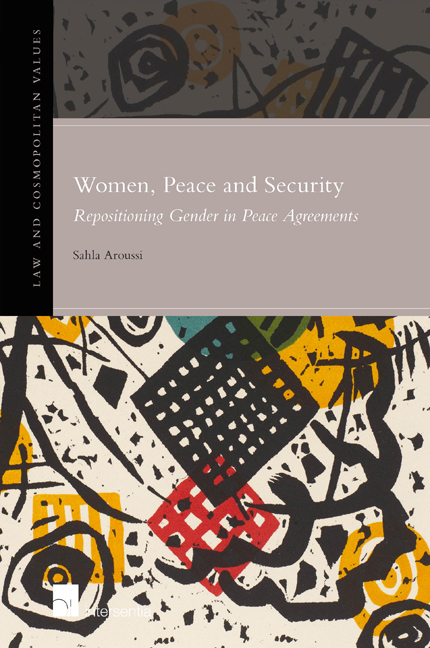Book contents
- Frontmatter
- Acknowledgements
- Contents
- List of Abbreviations
- List of Tables and Figures
- Introduction
- Chapter 1 The United Nations Resolutions on Women, Peace and Security
- Chapter 2 The Gender of Peace Agreements
- Chapter 3 Overview of Gender Provisions in Peace Agreements
- Chapter 4 Women's Political Participation in Peace Agreements
- Chapter 5 Gender-Based Violence
- Chapter 6 Perspectives from the Field
- Conclusion
- References
- Law and Cosmopolitan Values
- Instructions to authors
Chapter 4 - Women's Political Participation in Peace Agreements
Published online by Cambridge University Press: 12 December 2017
- Frontmatter
- Acknowledgements
- Contents
- List of Abbreviations
- List of Tables and Figures
- Introduction
- Chapter 1 The United Nations Resolutions on Women, Peace and Security
- Chapter 2 The Gender of Peace Agreements
- Chapter 3 Overview of Gender Provisions in Peace Agreements
- Chapter 4 Women's Political Participation in Peace Agreements
- Chapter 5 Gender-Based Violence
- Chapter 6 Perspectives from the Field
- Conclusion
- References
- Law and Cosmopolitan Values
- Instructions to authors
Summary
In the previous chapter I presented a wide range of data pertaining to the nature of the provisions dealing with gender issues in 112 peace agreements signed between 2000 and 2008. The analysis established that women's political participation and gender-based violence are the highest coded categories in this database (21 and 20 peace agreements respectively). The data also showed that these peace agreements do not reflect the broader agenda for participation espoused by resolution 1325 since women's appointments to the judiciary, and recruitment to re-structured police forces, the army and security forces remain hardly addressed at all. Agreements also continue to marginalise women's participation in DDR and in transitional justice and reconciliation processes. Most importantly the findings reveal that the issue of women's economic and social rights remain largely absent from most peace agreements. However, quantitative data, if not combined with other methods, only provide a limited understanding of the reality of implementation that may lead to hasty or misguided conclusions. Therefore, for a fuller picture it is important to move beyond figures to critically evaluate how these issues are being addressed in peace agreements. This chapter will focus on women's political participation not least because it is one of the most common issues in peace agreements but also because it is one of the three main focuses of resolution 1325 and is an area that many women's groups have actively and repeatedly drawn attention to.
The first part of this chapter critically engages with how the agenda on women, peace and security has treated the matter of women's political participation. This section will also map out how the peace agreements in the database have addressed the issue of women's political participation. The second part of this chapter attempts to answer the question of why peace agreements often address women's political participation but fail to tackle issues of women's economic and social inequalities that would, crucially, empower women and enable them to move towards gender equality as well as increased participation. The overall aim of the chapter is to reflect on the current impact of the UN agenda for women, peace and security on peace agreements. In pursuing this goal, I employ quantitative and qualitative data and include references to feminist literature, UN official documentation, peace agreements, and interviews conducted with elites within the field of peacemaking.
- Type
- Chapter
- Information
- Women, Peace, and SecurityRepositioning gender in peace agreements, pp. 153 - 192Publisher: IntersentiaPrint publication year: 2015

